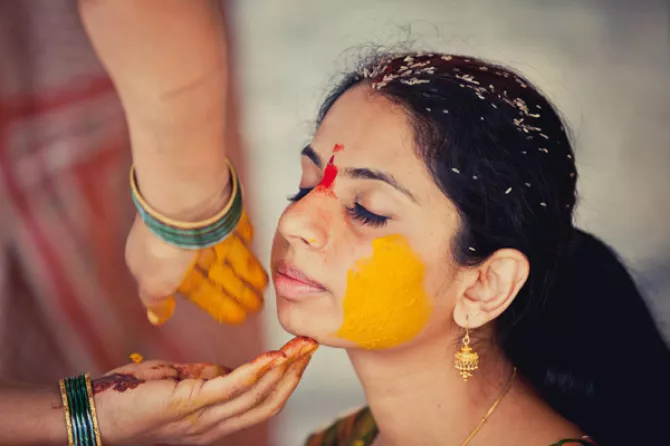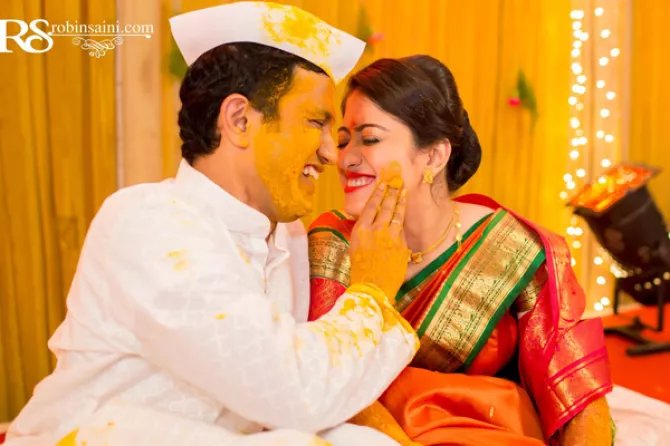HALDI
In our Indian culture, haldi or turmeric holds a special place of honour. It is known for its anti-inflammatory and other healing properties, because of which it has become popular as a medicine as well. And, one area where it holds the most importance place is when it comes to Indian traditions. In Indian weddings, this amazing ingredient has an entire ceremony to its name. You guessed it right! We are referring to the vibrant haldiceremony.
According to the ancient texts, there is significance for every ritual that forms a part of the Indian wedding, including the haldi ceremony. So, we decided to focus on this wonderful wedding ritual, and throw some light on its significance.
The haldi ceremony is the one in which a paste of haldi is applied on the bride and the groom’s body before their wedding. This ceremony is held at both the bride and the groom’s place, on the morning of the wedding day. In a few cultures, this ceremony is also held a day before the wedding, after the mehendi ritual. It is known by different names in different regions, like ubtan, mandha, tel baan, etc.
Traditionally, people make a paste using haldi and different ingredients according to their individual family customs. While some mix it with sandalwood powder and milk, others mix it with rose water. This paste is then applied on the bride and the groom’s face, neck, hands and feet, by their near and dear ones. This ceremony is also accompanied by traditional songs and dances at times.
In many customs, the bride and the groom also apply a small portion of this sacred paste on their unmarried friends and siblings. It is said that whoever gets touched by this paste will soon find a good looking partner.
Why haldi holds such a special place?
#1. To keep buri nazar (evil eye) away
Most people believe that the reason for applying haldi is to ward off evil spirits from affecting the bride and the groom. This is why, the bride and groom are usually not allowed to leave their home after the haldi ceremony, till their wedding mahurat. In some traditions, they are also tied a sacred red thread or given some small amulets and other items for protection against evil eye.
#2. The colour is auspicious
The yellow colour of turmeric is considered very auspicious in the Indian traditions. The auspiciousness of this ingredient and its colour ushers in a life of prosperity for the couple, who are starting off their new life together. This is why, in many cultures the bride and groom wear yellow clothes on their wedding day as well.
#3. For that extra glow
In the olden days, when cosmetic beauty treatments and parlours were not available, Indians had their own natural beauty secrets to ensure that a couple looked radiant and wonderful on their wedding day. Haldi is known to have properties that leave the skin fair and glowing.
#4. As an antiseptic
Since turmeric or haldi is known for its medicinal properties as well as being antiseptic, an application of this ingredient before marriage would ensure that the bride and groom are blessed with blemish-free skin. It also ensures that the couple is protected against any cuts, bruises or ailments before the wedding.
#5. Purification of the body

Haldi holds such an important place in Indian traditions because it also purifies and cleanses the body. It is known as an effective exfoliating agent. After the haldi ceremony, when the paste is rinsed off, it helps to get rid of dead cells and detoxifies the skin.
#6. Drives away pre-wedding jitters

Apart from its property of beautification, cleansing and detoxification, haldi is also known to alleviate some of the nervousness that the bride and the groom feel. Curcumin, an antioxidant that is present in turmeric, is known to work as a mild anti-depressant and a natural remedy for headaches as well. So, it is a good way to relieve wedding day anxiety and jitters. Haldi is also known to boost immunity, and also helps to soothe an upset stomach.






No comments:
Post a Comment